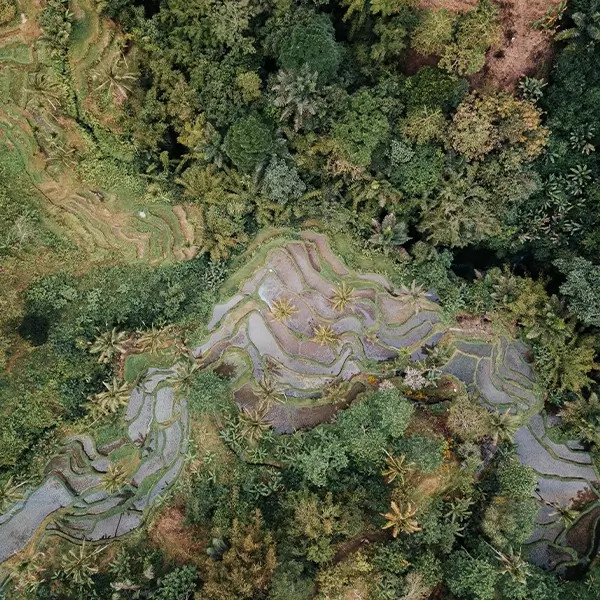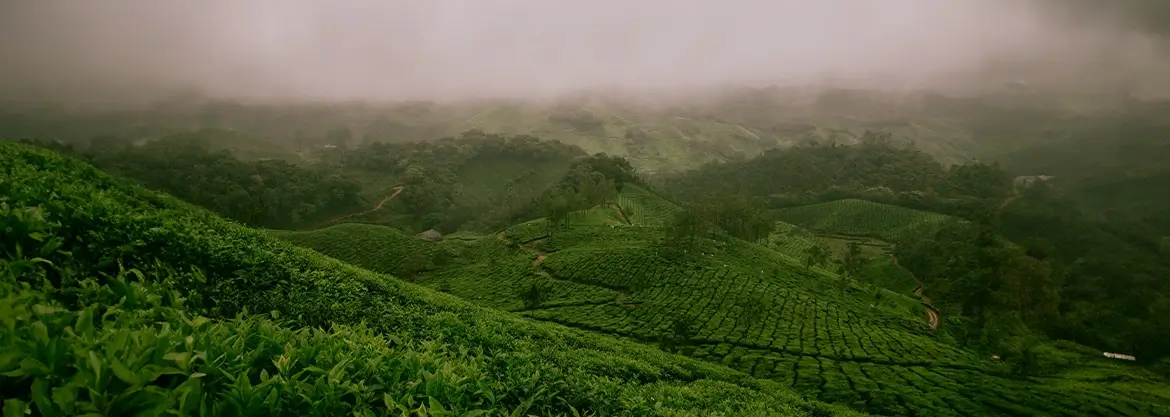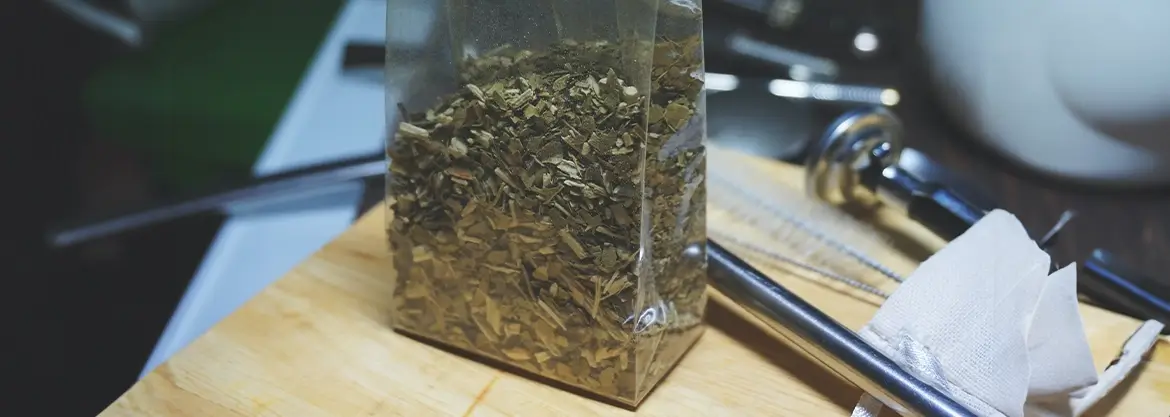How is yerba mate produced?

Pick the leaves, grind them, throw the whole thing into a mate cup and pour water over it? Too simple to be true! Cultivating Ilex paraguariensis and making yerba mate is a long process overseen by many people. In today's article, we take an in-depth look at the stages of production of our favourite dried mate tea. If you want to know how it happens that the holly leaves make their way from the bush to your calabash, we invite you to read on!
Summary:
- Yerba mate – what is it actually?
- From plantation to mate cup. What is the yerba mate production process like?
- Time for a tasting!
Yerba mate – what is it actually? Origin of yerba mate
If you are interested in the topic of yerba mate, you probably already know that it is an infusion prepared from the leaves of Ilex paraguariensis plant. Apart from this basic information, there are many other facts worth knowing about the unique drink of the Guarani Indians. Yerba mate originates from South America, more specifically from the borderlands of Argentina, Brazil, Paraguay and Uruguay. It is a drink integrally connected to the culture of these countries – its popularity status can be compared to that of coffee or tea in our country. Thanks to caffeine, yerba mate is stimulating and also contains a whole range of vitamins, minerals, antioxidants and many valuable properties. For some time now, yerba mate has been winning the hearts of fans of stimulating infusions all over the world, but few people realise how much work and care goes into the creation of each packet of this "Paraguayan tea". How is yerba mate made and what is the process of its production? Let's find out!
From plantation to mate cup. What is the yerba mate production process like?
The Paraguayan holly (Ilex paraguariensis) is a plant whose leaves (and twigs) are the main ingredients of the dried product found in a packet of yerba mate. Centuries ago, the properties of the plant were discovered by the indigenous people of South America. Methods of growing the holly, harvesting the mature crop and producing it were developed and have undergone innovations and improvements over time. However, it is said that for hundreds of years the taste and aroma of yerba mate have remained unchanged – it is exactly the same beverage that the Indians made and drank.
Cultivation of yerba mate
The process of producing yerba mate begins at the plantation. Here we have three basic cultivation methods. The first is to obtain holly seedlings directly from the forest wilderness. The plants have two sexes: female and male. Under natural conditions, the female variety is more common – it has a milder taste and lower caffeine content. For this reason, it is rarely or never found in organised cultures. The second school of thought involves mixing wild seedlings on the plantation with those obtained under cultivated conditions. It's kind of like a combination of nature and science. The third option is the most popular. Here, there is no longer the collection of wild plants in the forest, but the seedlings are propagated under special conditions on the plantation. Before they reach about 7 cm in height, they are kept in special greenhouses. They are then taken to the “nursery”, where they spend 6 to 12 months under the care of the yerbateros (plantation workers). After this time, the developed plants are transplanted to the field, where they wait 4 years to mature. Some varieties of yerba mate require even more patience – up to 5-7 years!

Production process
- Harvesting yerba mate leaves. Mature bushes are ready for the first harvest about 4-7 years after planting. They are then pruned again after 2-3 years. Harvesting takes place between May and October and, as with tea, the timing of the harvest affects the taste and characteristics of the infusion. Modern, high-tech yerba mate plantations use machinery, while smaller, more traditional plantations use human hands. The leaves and branches of the Paraguayan holly fall onto canvas spread under the shrubs, in which they are then packed and transported to the “factory”. There they undergo careful selection and further processing. Importantly, the harvested yerba mate leaves cannot wait long to be processed. After about 24 hours, when exposed to oxygen, temperature and moisture, the freshly picked leaves begin to ferment – a process of decomposition of organic substances takes place in them, so that they lose their valuable properties.
- Drying the mate leaves stops the oxidation process and preserves their properties. According to the traditional method, the drying of yerba mate takes place in two stages. The first stage – sapecado – is a fiery “shot” for the leaves. It lasts just 20-30 seconds, and the mate leaves are literally “dragged” through the living flames of the fire. Their outer surface reaches a temperature of around 400°C. This is enough to get rid of the moisture and kill all unwanted enzymes and micro-organisms. Inside, the leaves reach a temperature of 60°C, so that the valuable nutrients remain intact. The effect of contact with the fire is to change the colour of the leaves – they lose their green colour and become faded. In the second drying stage – secado – which is longer (lasting up to 24 hours) and at a lower temperature (up to 100°C), the holly leaves lose their remaining moisture. This used to be done on special scaffolding set up over a fire, where the heat and smoke dried the leaves. This method is called carijó and, in a heavily modified form, is still used today. Later, the barbacuá method was devised, in which the heat from the fire is conducted to the holly leaves through a special tunnel, so that they are not in direct contact with the fire. Today, only a few niche farms use this method. The process of drying yerba mate varies from one type to another. Manufacturers are always keen to bring out the best possible flavour, so they introduce their own innovations. The final taste and character of yerba mate is influenced by the length and parameters of each drying stage. Mate from Paraguay and Argentina, although produced in the spirit of tradition, differ in flavour and aromatic nuances. It is said to be smoked yerba mate because of its distinctive aroma and smoky aftertaste. In the production of Brazilian green yerba mate, on the other hand, smoke and fire are not used at all. Instead, the leaves are dried with hot air to preserve their original colour and avoid a smoky taste and smell.
- Grinding yerba mate – canchado takes place as soon as the leaves are dried. Using machines or in special mills, the dry Ilex paraguariensis leaves are crushed into smaller pieces and then packed in jute bags. Yerba mate that is at this stage of production is called canchada and is basically already suitable for brewing and drinking at this point, although the infusion made from it is very weak in taste and effect.
- Aging, seasoning or, from Spanish, beneficio, is a stage that, like drying, affects the taste, aroma and character of yerba mate. Packed in bags, the canchada is transferred to a well-ventilated, cool warehouse, where it “rests” from 8 months to as long as 3 years. With yerba mate it is like with wine – the “older”, longer it is aged, the more refined, deeper and bitterer it becomes. For example, Paraguayan, expressive mate is usually seasoned for around 2 years, while milder-tasting yerba from Argentina is put aside to age for up to 12 months.
- Grinding and sieving again. After the "rest" comes the time to give yerba mate its (almost) final shape. The holly leaves and twigs undergo re-grinding, the intensity of which is adjusted to how fine a dried product is desired. The difference between Paraguayan and Uruguayan mate, where, in addition to the fine leaves, the packet contains a considerable amount of dust, and Brazilian green mate, where the green mate consists almost exclusively of large, evenly cut holly leaves, can be seen with the naked eye. Sifting the dried mate, on the other hand, is a process that involves separating the leaves from the twigs and then recombining them. Sound strange? The reason is very simple. The sticks in yerba mate have no value – zero caffeine, zero flavour and zero aroma. They are a worthless filler, and the more of them there are in the dry product, the more they reduce its quality. This has been taken advantage of by manufacturers in their search for savings. Finally, the matter has been regulated by the relevant institutions, which have established the maximum number of sticks in dried yerba mate, and separating them from the leaves and recombining them helps to control their content precisely.

Enriching with additives and packaging of yerba mate
For classic yerba mate, the production process ends at this point. After seasoning, possible re-grinding and sieving, the dried product arrives in the packet and then on the shop shelves. As far as flavoured yerba is concerned, before being packed, it is enriched with a variety of additives: flavourings, oils, herbs, spices, fruit in various forms... The possibilities are almost endless! Depending on the intended use, the finished dried yerba mate comes in large bulk bags or in retail packs, which usually have a weight of 0.5 or 1 kg. Nowadays, many manufacturers also offer samples of 50 or 100 g so that customers can get an idea of the flavours and choose what suits their taste buds best.
Time for a tasting!
Oooh, at last, the final! As you can see for yourself, yerba mate goes a really long way before it ends up in our mate cup as an aromatic infusion. However, the long processing is well worth it. Yerba mate is, after all, irreplaceable! It is a fascinating drink that has many varieties, flavours and traditions. The production process, from harvesting the leaves of Ilex paraguariensis on the plantations to preparing the portion in the calabash, is full of secrets and curiosities. Whether you are a fan of traditional yerba mate or looking for a version without smoke and dust, it is worth exploring the world of this exciting drink. Now that you've learned the secrets of yerba mate production, it's time to find out what flavour is hidden in its leaves. Immerse yourself in the culture of South America and try yerba mate. It's a journey you won't regret!
Source of information:
- Wikipedia: Mate (drink), Yerba mate.
- C.I. Heck, E.G. De Mejia, Yerba Mate Tea (Ilex paraguariensis): A Comprehensive Review on Chemistry, Health Implications, and Technological Considerations, Journal of Food Science, 2007.
- A. Gawron-Gzella, J. Chanaj-Kaczmarek, J. Cielecka-Piontek, Yerba Mate – A Long but Current History, Nutrients, 2021.




